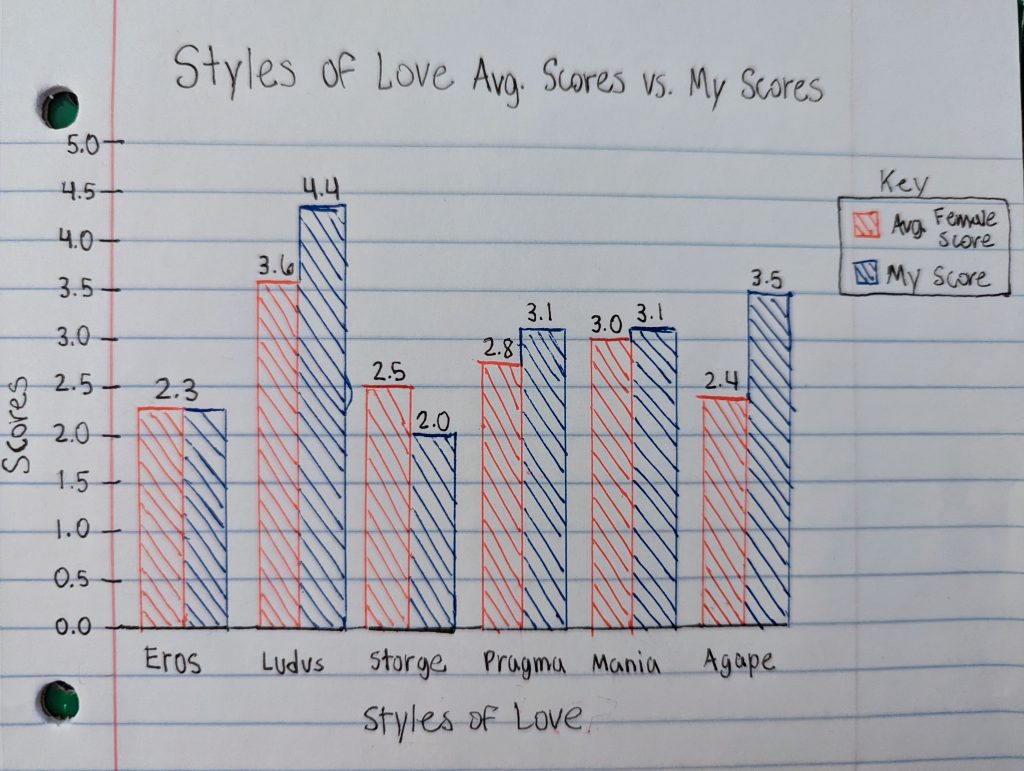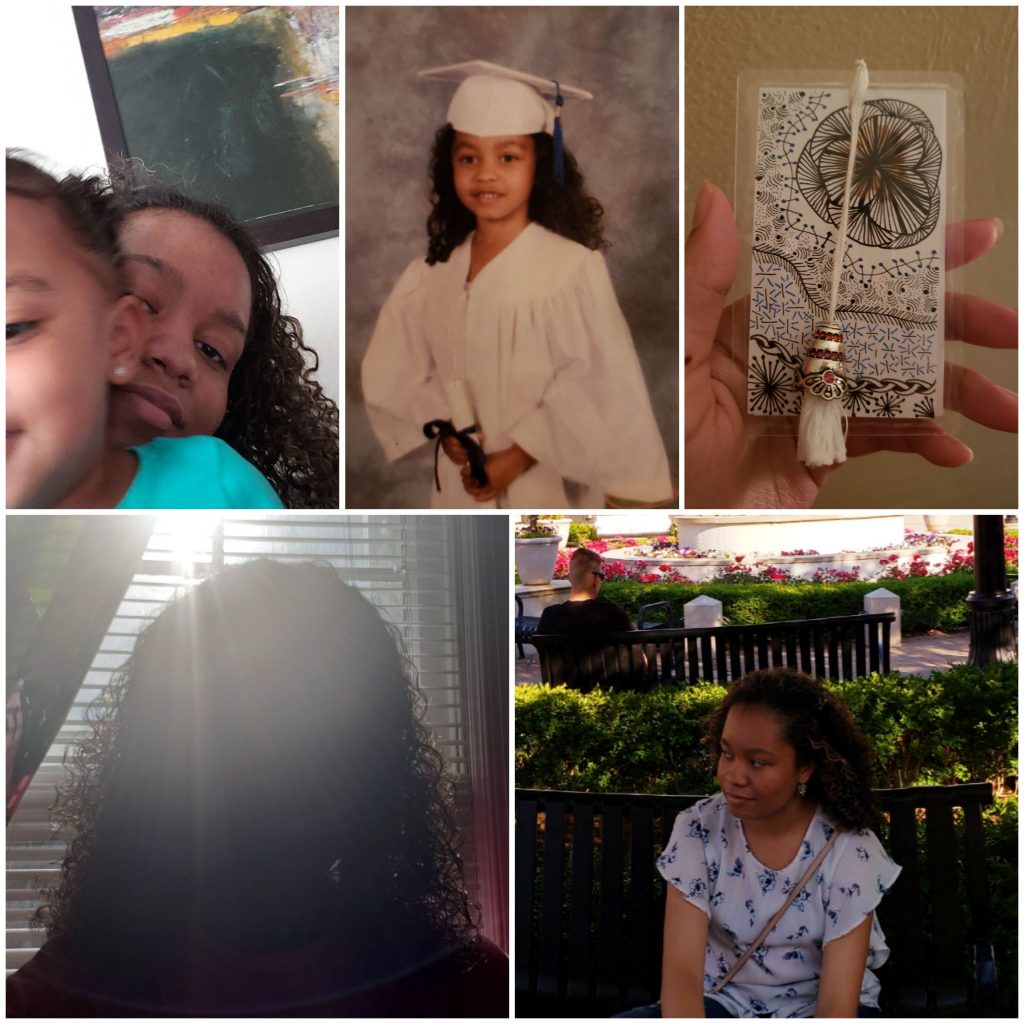ATA4
For the fourth assignment, I learned about the six styles of love, including eros, ludus, storge, pragma, mania, and agape. I then took a questionnaire in order to determine my scores for each style of love. Since I have never been in a relationship before, I answered the questions on the basis of what kind of relationship I would like to have in the future. This assessment helped me learn more about my own expectations and how I would realistically act in a romantic relationship. I was able to do this by graphing my results and comparing them with the average female scores so I could figure out how high or low I was for each style of love. The assignment was personally relevant to me because I realized how my personal relationship dynamics influenced my results. The bonds I have developed between myself and my friends has greatly affected my view of what an ideal relationship should be like. For example, the toxic friendships I have experienced have made me wish to avoid a romantic relationship full of manipulation and deceit. Studying these styles of love reminded me of a topic that I learned in the same chapter of the textbook, known as Sternberg’s triangular model of love. The model displays what Sternberg believes to be the three main components of love: intimacy, passion, and commitment. Based on how high or low these three categories are, six different types of love can form, including companionate love, empty love, fatuous love, infatuation, romantic love, and liking. I thought it was interesting how different psychologists have their own theories on what forms of love there are and how they influence relationships.

ATA3
For the third assignment, I watched a video in which a comedian named Michael Richards had a major outburst after he was apparently interrupted at a comedy club. Then I had to determine if what he said was racist, whether he was only intending to execute deep pain or if he was revealing a deep-rooted hatred for black people, and whether or not racial slurs can be said without a racist intent. I concluded by saying that his tirade was indeed racist, Richards himself is also racist, and racial slurs cannot be said without a racist intent. This assignment made me learn more about modern racism. Even though the words that Richards used was clearly racist, he claimed afterwards that he wasn’t actually racist and that he had simply had a moment of anger because he was interrupted. Examining this situation reminded me of a subject I learned earlier in the course, known as the actor-observer effect. This refers to how people attribute their own behavior to situational causes and attribute others behavior to dispositional causes. As the actor, Richards easily dismissed his own behavior as a result of the situation. But as an observer, I can recognize that his actions are a result of his own internal character, and not due to an external situation. The image below is a screenshot from Richards’ racial tirade, and it shows him saying how shocked the audience must be “to see what’s buried beneath.” In other words, he is admitting in this moment that this is who he really is. But then he later says that he is not actually racist, which I found to be puzzling. This assignment was personally relevant to me because I am African-American and Asian, and I have been in several situations in which people made insensitive comments about my race, but then later claimed that they were not actually racist and that they were just “joking”. But there is a lesson that I have learned over the years and it is this: when someone shows you who they really are, believe them.

ATA2
The second assignment required us to review at least six photos that represented who we are. Through this assignment, I was able to self-reflect and learn more about my own identity. For example, I learned how my role as an older sister has influenced my personality and growth as an individual. This piece of writing actually reminded me of similar assignments I did for my Art History class. In that class, I wrote a few papers analyzing pieces of artwork that were made by other people. The purpose of art analysis is to determine what sort of ideas the artist is trying to convey with certain features, such as colors and styles of brushstrokes. Examining my own pictures was similar in a way, since I was trying to figure out what these images revealed about myself. This assignment was relevant to me because I got to take a step back and judge my own character, which is something I don’t do often. But the experience was definitely an eye-opener for me, and I got to learn more about how I have grown into the person I currently am. Judging myself from the perspective of an outside observer allowed me to look back and remember the significant turning points of my life, such as when I got my learner’s permit and went to the mall with a friend of mine for the first time. I was also able to learn more about my roles as a student, an older sibling, a wallflower and a reader. The photo collage below shows all of these significant parts of myself. For privacy reasons, I posted almost all of the six photos I chose, aside from my learner’s permit.

ATA1
The Heuristics on Social Cognition assignment made me more aware of how often people use mental shortcuts to deal with complex decisions. I have always thought of myself as someone who does not make judgements without considering all of the important information, but working on this assignment made me realize that I am more susceptible to using heuristics than I previously thought. I am especially prone to using the status quo heuristic; rather than taking a chance and trying out new things, I usually prefer for things to stay the same. For example, I tend to reread the same books from authors that I am already familiar with, and I have always preferred to listen to music that was released during my childhood, rather than the newer songs released today. The realization that I am not the rational person that I thought I was reminded me of a concept I learned from my Interpersonal Communication class: cognitive dissonance. In simple terms, cognitive dissonance is a mental discomfort you feel when you realize that your actions contradict with your beliefs. In this case, I had realized that my frequent use of heuristics contradicts my personal belief that I am a person who does not make any judgements with incomplete information. There was only one way for me to resolve this feeling of cognitive dissonance: in the future, I will be more conscious of how much I rely on heuristics, so that my actions are in line with my beliefs about myself. For example, I am making more of an effort to listen to new albums that are released, in order to change my perception than older music is better. One album that I listened to was Constellations, which was recently released by an artist named RINI. I hyperlinked the album on Spotify to the cover art posted below, and I encourage those who love R&B music to listen to the album. It definitely changed my opinion that new music is not as good as older music.
